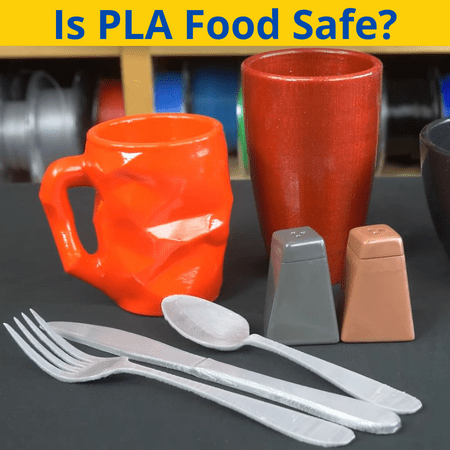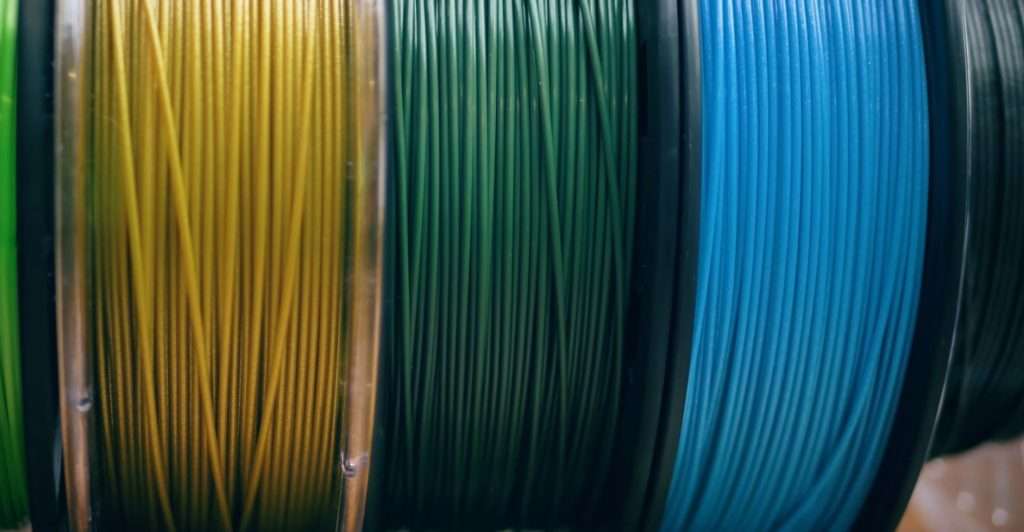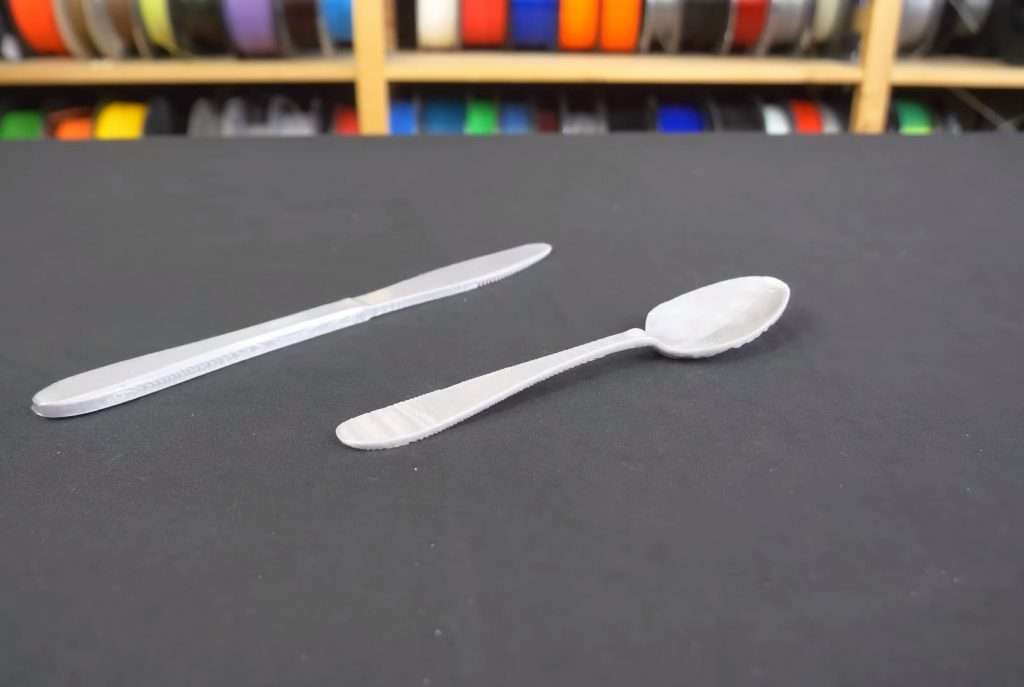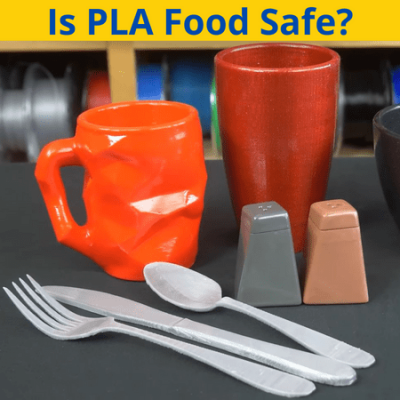
Polylactic acid, known as PLA in the 3D printing community, is the most popular filament material. PLA filaments offer easy printability, low temperature requirements, and decent print quality.
But is PLA food safe?
YES!
Whether you are 3D printing a dog food bowl or a Tupperware container, the food safe-ness of filament material is very important as you wouldn’t want to accidentally inject toxic chemicals.
PLA is considered a food safe material and it’s one of the safest filament materials to 3D print food-contact items. If you want to learn more about PLA, tips for printing food-safe items, and more, read on!
Table of Contents
What is PLA?
As we mentioned, PLA stands for Polylactic Acid and this material is a special type of thermoplastic. As a thermoplastic, PLA can be softened and melted when heated and solidified once cooled, and PLA has a low melting point, making it a great 3D printable material for low-budget 3D printers as the heating components don’t have to be very powerful.
Additionally, PLA is a somewhat flexible filament (not literally; it’s pretty rigid) when it comes to printing because not much tuning of your printer or slicer profile is necessary to achieve decent print quality.
So how is PLA made?
Raw PLA is sourced from plants, typically corn starch, sugar cane, tapioca, or potatoes, and these all-natural resources undergo intensive processes to bring out certain chemicals and reactions that result in the end-result PLA material.
As the main ingredients for PLA are plants, which are natural (and renewable) resources, PLA is considered bioplastic.

Due to the wide availability of the raw resources used to make this bioplastic, PLA is one of the least expensive filament materials out there. Depending on where you are, you should be able to purchase a 1-kilogram spool of PLA filament, which can last months, for between $18-25.
This is a lot less than other filament materials like polycarbonate and nylon which come from rarer materials and have more complex manufacturing processes that increase the production cost.
Given its low cost, wide availability, compatibility with most 3D printers, and easy printability, it comes as no surprise that PLA is the most popular filament material.
But how does it perform when it comes to food safety?
Keep reading to learn more!
Things to Keep in Mind While Using PLA
While PLA is naturally a food-safe filament material, this is only the case when it’s in a pure and raw form. Moreover, 100% PLA material plastic will have no negative reaction with food and doesn’t contain any harmful chemicals that would cause problems if the material touched food. However, there are many external factors that also contribute to the food safety of a model printed in PLA that you should keep in mind.
First off, most PLA filaments aren’t pure PLA and contain additives that further improve the printing performance of the material or control the visual appeal of the filament. While raw and pure PLA is food safe, these additives might not be.
Second, any dust, grease, or other chemicals or debris on your printer that rubs onto the filament can also make PLA prints not food safe. For example, the extruder drive gear on a 3D printer might have some grease or the nozzle may have a lead coating that can negatively impact the PLA’s food safety on its way out.

The third consideration is the fact that 3D printed models are naturally porous. Moreover, due to the layer-by-layer FDM 3D printing approach, there will always be small gaps and holes in printed models. Once a model is printed in PLA, these holes put the model at risk of absorbing non-food-safe substances like dust or other chemicals.
While these considerations certainly seem scary, their net effect on a 3D printed model’s food safety is relatively low. A few unnatural substances caused by the reasons we explained above won’t completely wipe away the material’s natural food safety. Of course, this does mean that you shouldn’t be eating PLA as there could be substances that potentially will harm you if ingested, but PLA isn’t probably the tastiest treat anyways.
How to Make PLA Food Safe?
So, with the considerations we explained in the previous section in mind, you may be wondering “How do I make PLA food safe”? There are a few important tips to follow to ensure that your 3D printed models are capable of safely handling food.
The first tip we have is to try to use a food-safe-rated PLA material such as those with FDA approval. As we mentioned, many PLA filaments contain non-food-safe additives, but FDA-approved PLA filaments should be guaranteed to be food safe, usually because they don’t have these additives (or the additives are also food safe).
Our second tip is to use a clean nozzle, preferably a stainless steel nozzle if available. That’s because stainless steel provides a non-stick surface that should repel any unwanted substances like excess metal or extra filament material that try to stick to the nozzle. A cleaner nozzle means less potential contamination of your filament on its way out of the hot end.
Third, apply a food-safe coating around your 3D printed models to ensure that they can safely contact food. Adding a spray-on or paint-on coating, like a food grade Epoxy, to a 3D print successfully requires a smooth and non-porous surface on the model, so try to achieve this on your print by using a larger layer height or more walls. Make sure to read the instructions provided by the manufacturer of the coating when applying it to your model!
Risks of Not Using Food Safe 3D Filament
So what’s the big deal with not using a food safe 3D printing filament? Well, you will likely not experience any issues, but it’s still not a risk worth taking.
Non-food-safe 3D printing filaments, like most ABS filaments, usually come from unnatural resources like oil or natural gas and contain harsh additives that make the material not great for handling food. If you print food-contact models with these materials, you’re not going to start having an allergic reaction on the spot, though.
Instead, any harmful damage the non-food-safe material might cause will be very minor and virtually untraceable. Nonetheless, in this scenario, the safe route is the best route, which is why we strongly suggest using a PLA filament as it’s a food-safe material.
What is the Best Food Safe PLA Filament?
Although, technically any PLA filament can be considered food safe, not all PLA filaments have the same level of food safety. PLA filaments with approval from the United States Food and Drug Administration (FDA) are considered the safest for food contact as they have undergone investigation and meet rigorous food safety requirements.
So, what are your options?
Filaments.ca is a Canadian manufacturer of 3D printing filaments and their TRUE Food Safe PLA is one of the few FDA-approved PLA filaments on the market, and it’s available in a few different colors like pink, green, brown, and red. The same manufacturer also sells EconoFil, a line of PLA filament focused on food safety. While it doesn’t have FDA approval, it’s very inexpensive and should be a very reliable option.
Another line of FDA-approved PLA filament is Extrudr’s NX-2, and it comes in 25 colors, with two filament diameters (1.75 and 2.85 mm). According to Extruder, NX-2 filament is great for producing detail on models and offers a visually aesthetic matte finish. Extrudr’s GreeTec Pro is also FDA-approved and offers high temperature resistance with minimal warping during printing.
Want more options?
Hatchbox PLA is a relatively inexpensive filament and, though it doesn’t have FDA approval, many users print food contact items, like fruit bowls, with it.
Fillamentum’s Exrtrafill PLA also doesn’t have FDA approval, but the manufacturer boasts excellent food safety and mechanical properties (e.g. strength).
What Other Food Grade Materials can be Used in 3D Printing?
Although PLA is the most popular 3D printing filament and the one most known in the 3D printing community as food safe, it’s not the only food-safe material. PETG, Polycarbonate, and Nylon are three other food safe materials that you can use to print food-contact-ready objects.
If you’re looking for the “best” food safe material, the answer depends on what you want to 3D print.
If you’re just getting into 3D printing, then PLA is probably your best bet as it’s the easiest to make high-quality models with, the most available, least expensive, and the material is generally recognized as food safe.
For printing models that need to be very rigid, strong, and durable against the elements (e.g. sunlight), PETG is the way to go as it’s also food safe. PETG is an altered version of PET, the material commonly used for water bottles and other classic food containers. It’s also dishwasher safe!
Finally, if you have a slightly larger filament budget and want a strong filament that’s also a little flexible and impact resistant, nylon is your best bet.
The Bottomline
Whether you’re printing a bowl for candy or a cutting board, food safety is something that you want in a filament as it reduces the chance of contamination or injury. PLA is one of the best filaments to print food contact items for as the material is natural food safe.
Still, there are a host of factors that could potentially alter your PLA print’s food safety, such as debris in the nozzle. Luckily, you can reduce the chance of contaminants by following a few tips like using an FDA-approved PLA filament and a stainless steel nozzle.


